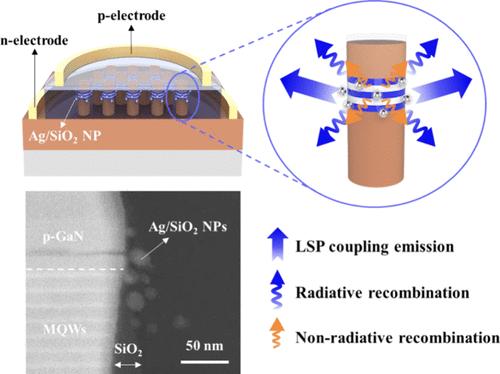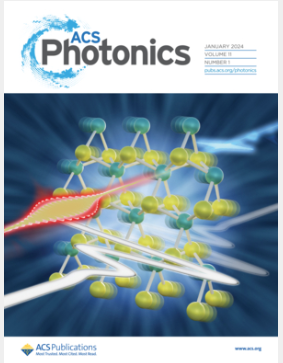探索局部表面等离子体激元和溶胶-凝胶钝化对蓝色InGaN/GaN微/纳米发光二极管的影响
IF 6.5
1区 物理与天体物理
Q1 MATERIALS SCIENCE, MULTIDISCIPLINARY
引用次数: 0
摘要
微发光二极管(μ led)和纳米发光二极管(nled)作为下一代显示器的潜在候选者正引起人们的广泛关注。然而,随着μ led和nled尺寸的减小,它们都面临着降低外部量子效率(EQE)的主要挑战。为了解决这一问题,本研究探讨了局部表面等离子体(LSP)和溶胶-凝胶钝化对蓝色μ led和nLED阵列性能的影响。nLED阵列由多个nLED组成,设计成与μ led具有相同的芯片面积。与μ led相比,nLED阵列具有更大的表面体积比,由于表面复合等影响而导致效率降低。然而,nLED允许Ag/SiO2纳米颗粒放置在多量子阱暴露的侧壁附近,并且在最大化LSP耦合效应和增强溶胶-凝胶钝化效果方面具有优势。结果表明,当两种效应同时作用时,随着尺寸从10 μm增加到50 μm, μ led的EQE值从3.47% ~ 7.02%增加到5.64% ~ 8.08%,nled的EQE值从1.29% ~ 5.22%增加到4.90% ~ 9.60%。其中,LSP耦合效应在nled中的EQE增强幅度为50% ~ 200%,明显高于μ led。该方法提供了LSP耦合效应结合溶胶-凝胶钝化对提高下一代显示器μ led和nled效率的影响本文章由计算机程序翻译,如有差异,请以英文原文为准。

Exploring the Influence of Localized Surface Plasmon and Sol–Gel Passivation on Blue InGaN/GaN Micro/Nano Light Emitting Diodes
Micro light-emitting diodes (μLEDs) and nano LEDs (nLEDs) are attracting considerable interest as potential candidates for next-generation displays. However, both μLEDs and nLEDs encounter the major challenge of decreasing the external quantum efficiency (EQE) as their size diminishes. To address this issue, this study explores the effect of localized surface plasmon (LSP) and sol–gel passivation on the performance of blue μLEDs and nLED arrays. The nLED arrays are composed of several nLEDs and are designed to have the same chip area as the μLEDs. The nLED arrays have a larger surface-to-volume ratio compared to μLEDs, resulting in lower efficiency due to effects such as surface recombination. However, the nLED allows Ag/SiO2 nanoparticles to be positioned in proximity to the sidewalls where the multi-quantum wells are exposed and has an advantage in maximizing the LSP coupling effect and enhancing the impact of sol–gel passivation. As a result, when both effects are applied, the EQE values increased from 3.47%–7.02% to 5.64%–8.08% for μLEDs and from 1.29%–5.22% to 4.90%–9.60% for nLEDs, as the size increases from 10 to 50 μm. Specifically, the EQE enhancement resulting from the application of the LSP coupling effect in nLEDs ranges from 50%–200%, which is significantly higher compared to μLEDs. The proposed approach provides insights into the influence of the LSP coupling effect combined with sol–gel passivation on enhancing the efficiency of μLEDs and nLEDs for next-generation displays
求助全文
通过发布文献求助,成功后即可免费获取论文全文。
去求助
来源期刊

ACS Photonics
NANOSCIENCE & NANOTECHNOLOGY-MATERIALS SCIENCE, MULTIDISCIPLINARY
CiteScore
11.90
自引率
5.70%
发文量
438
审稿时长
2.3 months
期刊介绍:
Published as soon as accepted and summarized in monthly issues, ACS Photonics will publish Research Articles, Letters, Perspectives, and Reviews, to encompass the full scope of published research in this field.
 求助内容:
求助内容: 应助结果提醒方式:
应助结果提醒方式:


